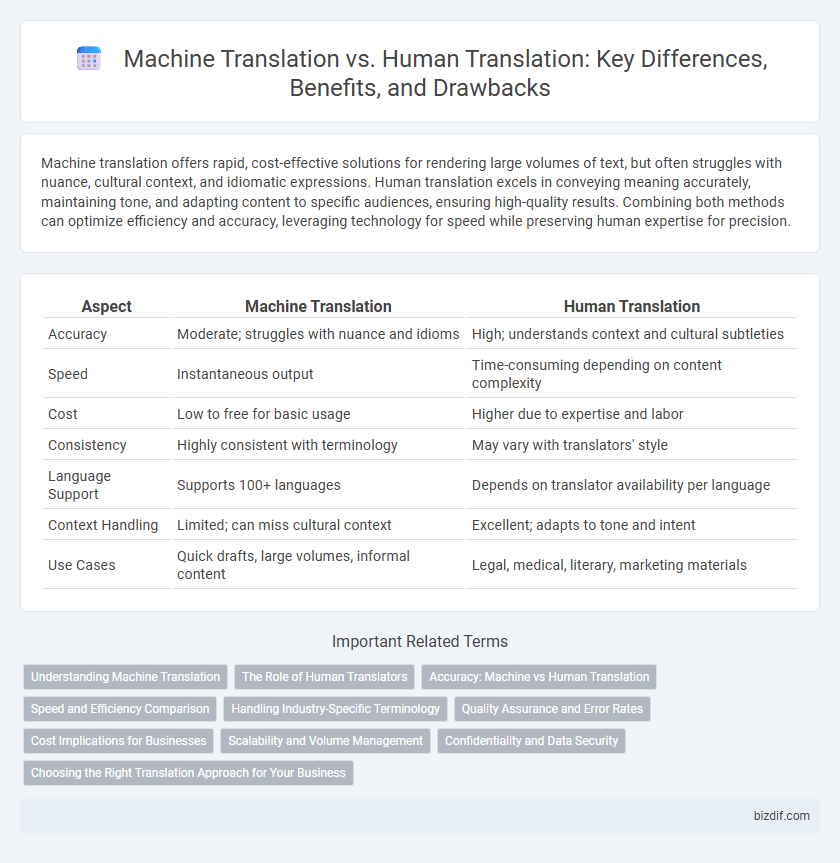Machine translation offers rapid, cost-effective solutions for rendering large volumes of text, but often struggles with nuance, cultural context, and idiomatic expressions. Human translation excels in conveying meaning accurately, maintaining tone, and adapting content to specific audiences, ensuring high-quality results. Combining both methods can optimize efficiency and accuracy, leveraging technology for speed while preserving human expertise for precision.
Table of Comparison
| Aspect | Machine Translation | Human Translation |
|---|---|---|
| Accuracy | Moderate; struggles with nuance and idioms | High; understands context and cultural subtleties |
| Speed | Instantaneous output | Time-consuming depending on content complexity |
| Cost | Low to free for basic usage | Higher due to expertise and labor |
| Consistency | Highly consistent with terminology | May vary with translators' style |
| Language Support | Supports 100+ languages | Depends on translator availability per language |
| Context Handling | Limited; can miss cultural context | Excellent; adapts to tone and intent |
| Use Cases | Quick drafts, large volumes, informal content | Legal, medical, literary, marketing materials |
Understanding Machine Translation
Machine translation leverages advanced algorithms and neural networks to convert text between languages rapidly, often handling vast amounts of data with consistency. Despite significant improvements, it struggles with nuances, idiomatic expressions, and cultural context that human translators naturally interpret. Understanding machine translation requires recognizing its strengths in speed and scalability alongside its limitations in capturing subtle meaning and emotional tone.
The Role of Human Translators
Human translators ensure nuanced understanding and cultural context in translations, addressing subtleties that machine translation algorithms often miss. They adapt tone, idiomatic expressions, and industry-specific terminology to deliver content that resonates with target audiences. Their expertise is crucial for high-stakes documents requiring accuracy, confidentiality, and personalized communication.
Accuracy: Machine vs Human Translation
Human translation consistently delivers higher accuracy due to its ability to understand context, idiomatic expressions, and cultural nuances, which machines often misinterpret. Machine translation, while significantly faster and cost-effective, struggles with complex language structures and subtleties, leading to frequent errors or awkward phrasing. For critical documents requiring precision, human translation remains the preferred choice to ensure clarity and correctness.
Speed and Efficiency Comparison
Machine translation offers unparalleled speed by instantly processing vast amounts of text, making it ideal for high-volume projects requiring rapid turnaround. Human translation, while slower, ensures nuanced understanding and context accuracy that machines currently cannot replicate. Efficiency in machine translation excels in scalability and cost-effectiveness, whereas human translation delivers precision essential for culturally sensitive or specialized content.
Handling Industry-Specific Terminology
Machine translation leverages advanced algorithms and large datasets to quickly process industry-specific terminology, yet it often struggles with context nuances and idiomatic expressions unique to specialized fields. Human translation excels in accurately interpreting and adapting complex technical terms, ensuring precise meaning and cultural relevance within industry contexts. Combining both approaches can enhance translation quality by balancing speed and contextual accuracy for specialized content.
Quality Assurance and Error Rates
Machine translation systems often deliver rapid results but struggle with nuanced language and cultural context, leading to higher error rates compared to human translation. Human translators excel in quality assurance by interpreting idiomatic expressions and maintaining tonal accuracy, significantly reducing mistakes. Combining advanced neural machine translation with human post-editing enhances overall translation quality and minimizes semantic errors.
Cost Implications for Businesses
Machine translation significantly reduces costs for businesses by enabling rapid, large-scale content processing without high human labor expenses. Human translation, while more costly due to specialized skills and time requirements, ensures superior accuracy and cultural nuance crucial for brand reputation and customer trust. Combining both can optimize budget without compromising quality, allocating machine translation for bulk tasks and human expertise for critical communications.
Scalability and Volume Management
Machine translation excels in scalability and volume management by processing thousands of words per minute, making it ideal for large-scale projects with tight deadlines. Human translation, while slower, offers nuanced understanding and cultural context, ensuring accuracy in complex or sensitive content. Combining both methods optimizes efficiency and quality for businesses managing diverse translation needs.
Confidentiality and Data Security
Machine translation offers rapid processing but poses significant risks to confidentiality and data security due to potential exposure of sensitive information through cloud-based servers. Human translation, by contrast, ensures higher data protection as translators can operate under strict confidentiality agreements and utilize secure offline environments. Choosing human translators is crucial for industries handling proprietary or classified content to mitigate data breaches and maintain privacy compliance.
Choosing the Right Translation Approach for Your Business
Choosing between machine translation and human translation depends on the complexity and nuance of your business content. Machine translation offers speed and cost-efficiency for large volumes of straightforward text, while human translation ensures accuracy, cultural relevance, and tone for specialized or sensitive materials. Evaluating the purpose, target audience, and required quality level helps determine the best approach to meet your business communication goals.
Machine Translation vs Human Translation Infographic

 bizdif.com
bizdif.com